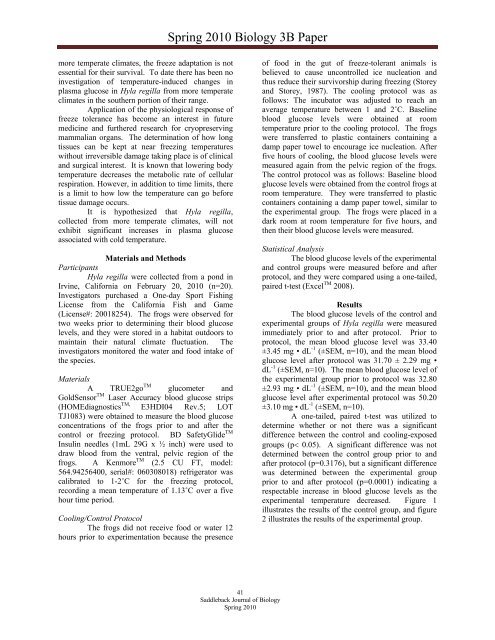Saddleback Journal of Biology - Saddleback College
Saddleback Journal of Biology - Saddleback College
Saddleback Journal of Biology - Saddleback College
Create successful ePaper yourself
Turn your PDF publications into a flip-book with our unique Google optimized e-Paper software.
Spring 2010 <strong>Biology</strong> 3B Paper<br />
more temperate climates, the freeze adaptation is not<br />
essential for their survival. To date there has been no<br />
investigation <strong>of</strong> temperature-induced changes in<br />
plasma glucose in Hyla regilla from more temperate<br />
climates in the southern portion <strong>of</strong> their range.<br />
Application <strong>of</strong> the physiological response <strong>of</strong><br />
freeze tolerance has become an interest in future<br />
medicine and furthered research for cryopreserving<br />
mammalian organs. The determination <strong>of</strong> how long<br />
tissues can be kept at near freezing temperatures<br />
without irreversible damage taking place is <strong>of</strong> clinical<br />
and surgical interest. It is known that lowering body<br />
temperature decreases the metabolic rate <strong>of</strong> cellular<br />
respiration. However, in addition to time limits, there<br />
is a limit to how low the temperature can go before<br />
tissue damage occurs.<br />
It is hypothesized that Hyla regilla,<br />
collected from more temperate climates, will not<br />
exhibit significant increases in plasma glucose<br />
associated with cold temperature.<br />
Materials and Methods<br />
Participants<br />
Hyla regilla were collected from a pond in<br />
Irvine, California on February 20, 2010 (n=20).<br />
Investigators purchased a One-day Sport Fishing<br />
License from the California Fish and Game<br />
(License#: 20018254). The frogs were observed for<br />
two weeks prior to determining their blood glucose<br />
levels, and they were stored in a habitat outdoors to<br />
maintain their natural climate fluctuation. The<br />
investigators monitored the water and food intake <strong>of</strong><br />
the species.<br />
Materials<br />
A TRUE2go TM glucometer and<br />
GoldSensor TM Laser Accuracy blood glucose strips<br />
(HOMEdiagnostics TM, E3HDI04 Rev.5; LOT<br />
TJ1083) were obtained to measure the blood glucose<br />
concentrations <strong>of</strong> the frogs prior to and after the<br />
control or freezing protocol. BD SafetyGlide TM<br />
Insulin needles (1mL 29G x ½ inch) were used to<br />
draw blood from the ventral, pelvic region <strong>of</strong> the<br />
frogs. A Kenmore TM (2.5 CU FT, model:<br />
564.94256400, serial#: 060308018) refrigerator was<br />
calibrated to 1-2˚C for the freezing protocol,<br />
recording a mean temperature <strong>of</strong> 1.13˚C over a five<br />
hour time period.<br />
Cooling/Control Protocol<br />
The frogs did not receive food or water 12<br />
hours prior to experimentation because the presence<br />
<strong>of</strong> food in the gut <strong>of</strong> freeze-tolerant animals is<br />
believed to cause uncontrolled ice nucleation and<br />
thus reduce their survivorship during freezing (Storey<br />
and Storey, 1987). The cooling protocol was as<br />
follows: The incubator was adjusted to reach an<br />
average temperature between 1 and 2˚C. Baseline<br />
blood glucose levels were obtained at room<br />
temperature prior to the cooling protocol. The frogs<br />
were transferred to plastic containers containing a<br />
damp paper towel to encourage ice nucleation. After<br />
five hours <strong>of</strong> cooling, the blood glucose levels were<br />
measured again from the pelvic region <strong>of</strong> the frogs.<br />
The control protocol was as follows: Baseline blood<br />
glucose levels were obtained from the control frogs at<br />
room temperature. They were transferred to plastic<br />
containers containing a damp paper towel, similar to<br />
the experimental group. The frogs were placed in a<br />
dark room at room temperature for five hours, and<br />
then their blood glucose levels were measured.<br />
Statistical Analysis<br />
The blood glucose levels <strong>of</strong> the experimental<br />
and control groups were measured before and after<br />
protocol, and they were compared using a one-tailed,<br />
paired t-test (Excel TM 2008).<br />
Results<br />
The blood glucose levels <strong>of</strong> the control and<br />
experimental groups <strong>of</strong> Hyla regilla were measured<br />
immediately prior to and after protocol. Prior to<br />
protocol, the mean blood glucose level was 33.40<br />
±3.45 mg • dL -1 (±SEM, n=10), and the mean blood<br />
glucose level after protocol was 31.70 ± 2.29 mg •<br />
dL -1 (±SEM, n=10). The mean blood glucose level <strong>of</strong><br />
the experimental group prior to protocol was 32.80<br />
±2.93 mg • dL -1 (±SEM, n=10), and the mean blood<br />
glucose level after experimental protocol was 50.20<br />
±3.10 mg • dL -1 (±SEM, n=10).<br />
A one-tailed, paired t-test was utilized to<br />
determine whether or not there was a significant<br />
difference between the control and cooling-exposed<br />
groups (p 0.05). A significant difference was not<br />
determined between the control group prior to and<br />
after protocol (p=0.3176), but a significant difference<br />
was determined between the experimental group<br />
prior to and after protocol (p=0.0001) indicating a<br />
respectable increase in blood glucose levels as the<br />
experimental temperature decreased. Figure 1<br />
illustrates the results <strong>of</strong> the control group, and figure<br />
2 illustrates the results <strong>of</strong> the experimental group.<br />
41<br />
<strong>Saddleback</strong> <strong>Journal</strong> <strong>of</strong> <strong>Biology</strong><br />
Spring 2010

















